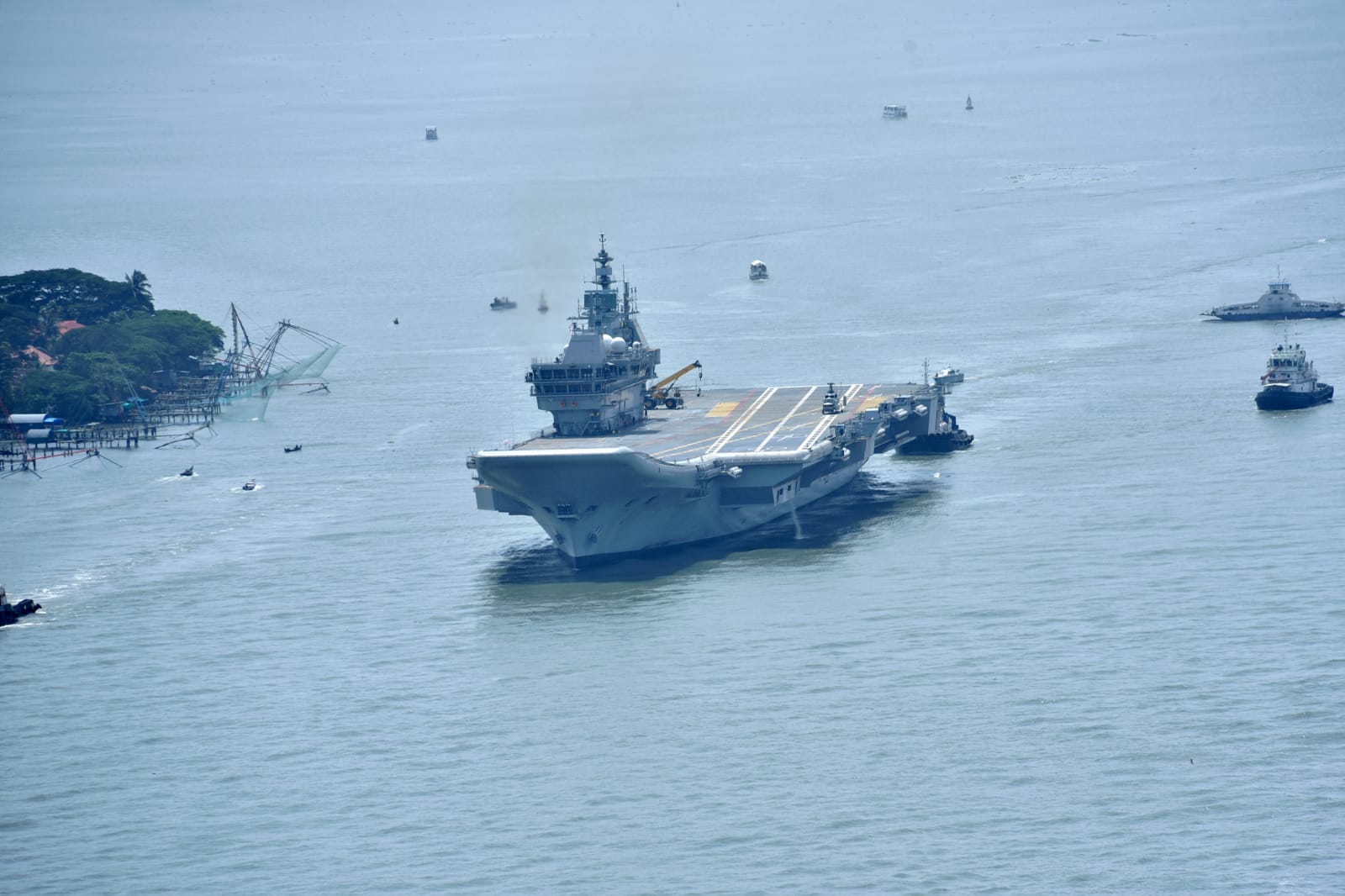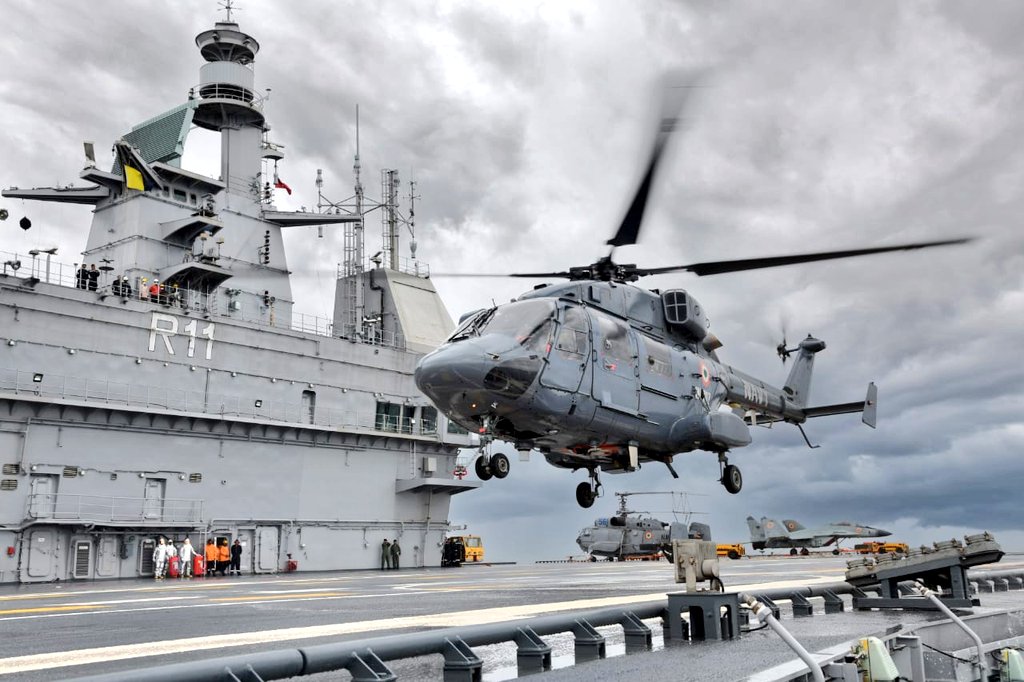India’s homegrown aircraft carrier, INS Vikrant, completed the fourth phase of sea trials on July 10, which involved integrated trials of major equipment and system on board, including some of the Aviation Facilities Complex equipment, said the Indian Navy.
The ship is expected to be delivered by the end of July, following which it could be commissioned on August 15, coinciding with the 75th year of Indian Independence.
“Indigenous aircraft carrier Vikrant completed 4th phase of sea trials integrated trials of major equipment and systems, including key aviation equipment undertaken with further enhancement in performance, towards the delivery of the largest indigenous warship in Azadi Ka Amrit Mahotsav,” the Navy said in a tweet.
The Navy also released images of the new aircraft carrier, one of which shows INS Vikrant from a distance and the other shows a Naval Dhruv helicopter hovering above the flight deck. A MiG-29K fighter jet and a Kamov Ka-31 helicopter are also parked on the flight deck.
Indigenous Aircraft Carrier #Vikrant successfully completed 4th phase of Sea Trials
Integrated trials of major eqpt & systems, incl key aviation eqpt undertaken with further enhancement in performance, towards delivery of the largest indigenous warship in #AzadiKaAmritMahotsav pic.twitter.com/Kv3OlUJuV9— SpokespersonNavy (@indiannavy) July 10, 2022
Designed by the Indian Navy’s Directorate of Naval Design (DND), Vikrant has been built at the state-owned Cochin Shipyard Limited (CSL) with 76% indigenous content, putting India in an elite club of countries – the US, the UK, Russia, France, and China – that can build aircraft carriers.

“The Indigenous design and construction of an Aircraft Carrier by the Indian Navy and Cochin Shipyard Ltd is a shining example in the Nation’s quest for ‘AatmaNirbhar Bharat’ and ‘Make in India Initiative’ with more than 76% indigenous content,” the Navy said in a press release.
INS Vikrant’s maiden sea trials were completed in August 2021, following which the second and third phases of sea trials took place in October 2021 and January 2022, respectively.
During these three phases of trials, endurance tests were conducted on the propulsion machinery, electrical & electronic suites, deck machinery, lifesaving appliances, and the ship’s Navigation and Communication systems.
India’s Vikrant vs China’s Fujian
The arrival of INS Vikrant marks a significant boost to the Indian Navy’s power projection capabilities amid rising tensions with China and increasing forays of China’s People’s Liberation Army (PLA) Navy in the Indian Ocean Region (IOR).
With two aircraft carriers in the fleet, even if one goes for maintenance, the other will remain functional. Additionally, the Indian Navy wants to acquire a third aircraft carrier.
On the other hand, China also launched its Fujian or the Type 003 aircraft carrier on June 17. Named after the Chinese Fujian province, Type 003 is China’s third aircraft carrier and the first one with a fully indigenous design.
Experts suggest the Fujian will probably be used to project Chinese power in the South China Sea (SCS) and the Indian Ocean.
So far, China is not known to have released the detailed specifications of the Fujian, except that it has a displacement of more than 80,000 tons which is more than double the 37,500-40,000 ton displacement capacity of the Vikrant.

Also, Fujian may be the largest non-American aircraft carrier in the world, with its length said to be about 320 meters and width about 73 meters, based on satellite images.
The INS Vikrant is only 262 meters long with a beam of 62 meters and a height of 59 meters. It has 14 decks, five in the superstructure, and 2,300 compartments, and it can house a crew of 1,700, including special cabins for women officers.
Based on the ski-jump ramp technology, Vikrant can operate Short Take-Off but Arrested Landing (STOBAR) aircraft with two take-off runways and a landing strip with three arrester wires.
Initially, Vikrant will operate roughly 24 Russian-built MiG-29K fighter jets also deployed on the INS Vikramaditya. However, the Indian Navy is also procuring a fleet of deck-based fighter jets, for which it has shortlisted Boeing’s F/A-18E Super Hornet and Dassault Aviation’s Rafale-M (Marine) aircraft.

In addition, the warship will also operate Kamov-31 helicopters, MH-60R multi-role helicopters, and other indigenously built advanced light helicopters.
Whereas Fujian has a much more advanced system to launch its aircraft, the Electromagnetic Aircraft Launch System (EMALS) enables the aircraft carrier to launch a broader range of aircraft.
The ski-jump ramp on a carrier flight deck allows an aircraft to take off from a runway shorter than its required take-off roll but still powered by its power.
On the other hand, the EMALS uses powerful magnetic fields generated by electromagnetic induction motors that power the catapults to propel the aircraft, just like the steam-powered catapults used in the CATOBAR (Catapult Assisted Take-Off But Arrested Recovery) technology.
Compared to the ski-jump ramp that Vikrant uses, the electromagnetic catapults of Fujian can propel heavier aircraft at much faster speeds, thereby allowing the latter to launch fighter jets loaded with more ammunition.
The EMALS can also launch drones and large transport aircraft that are better than the transport helicopters on aircraft carriers in terms of range, speed, and cargo capacity.
Furthermore, the electromagnetic catapults can launch large reconnaissance aircraft fitted with airborne warning and control systems (AWACS), increasing the range at which adversaries can be detected in advance.
Fujian will operate the J-15T, a catapult-enabled version of the J-15B that flies from the STOBAR ski-jumps onboard the Type 001 ‘Liaoning’ and Type 002 ‘Shandong’ aircraft carriers.

The J-15 Flying Shark is inspired by Russian Sukhoi Su-33. It is presently the only carrier-borne fighter in PLA Navy’s service, with the FC-31 ‘Gyrfalcon’ being tested and awaiting serial production.
Also, as earlier reported by EurAsian Times, Fujian could eventually get electronic warfare (EW) variant of the J-15, just like the EA-18 Growler EW aircraft of the US Navy based on the F/A-18 Super Hornet; a next-generation stealth fighter jet said to be the J-35; a fixed-wing early warning aircraft dubbed the KJ-600; armed reconnaissance drones, and the Y-7 transport aircraft.
- Contact the author at tanmaykadam700@gmail.com
- Follow EurAsian Times on Google News





